F.L.A.S.H.
Forces: Land ~ Air ~ Sea ~ Home
A MILITARY TRIBUTE WEBZINE . . . AS YOU WERE . . .
www.hillmanweb.com/flash
Compiled by Bill Hillman
FLASH. . . Editor and Webmaster: Bill Hillman: hillmans@wcgwave.ca
www.hillmanweb.com/rcaf/mag
APRIL 2002
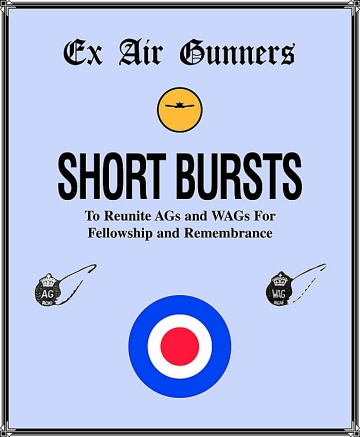
Bill Hillman Presents
F.L.A.S.H.
Forces: Land ~ Air ~ Sea ~ Home
A MILITARY TRIBUTE WEBZINE . . . AS YOU WERE . . .
www.hillmanweb.com/flash
Compiled by Bill Hillman
FLASH. . . Editor and Webmaster: Bill Hillman: hillmans@wcgwave.ca
www.hillmanweb.com/rcaf/mag
APRIL 2002
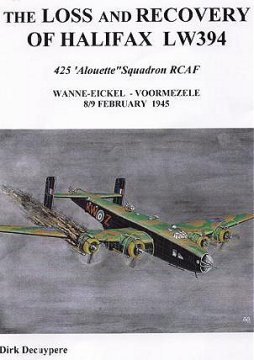
The following contains extracts
from
Dirk Decuypere's 28 page report
on the recovery of Halifax LW394
On Sunday 3 September 2000 a team of amateur archeologists, led by Wim Huyghe, succeeded in recovering Halifax 111 LW394 KW-Z of 425 Squadron RCAF at Voormezele Belgium. In the night of 8/9 September 1945 the Halifax, piloted by F/O Mark, had been hit by flak over Germany.The tracing of the precise point of impact on the crashsite was far from an easy job, though we could base ourselves on the memories of some eye witnesses of the crash. Farmer Frans Vandenbroucke, the owner of the field, rightly demanded concrete evidence from Wim Huyghe – who took the initiative for the recovery and received my cooperation – that he was standing on the right place before allowing him to dig with a crane. After all, the field was underdrained with a network of stone drainpipes which he did not want to break or damage unnecessary.
Secondly, it should be stressed that detecting WW 11 aircraft wrecks in the area of West Flanders has always been a tedious job, since the underground is strewn with World War 1 material (unexploded grenades or shrapnels, bullets, relics of armament etc….) and often makes the detector bleep all the time!
On Saturday morning 12 August 2000 we had Nico Brouchaert search the field with two metal detectors, but without success. The haul of World War 1 shrapnels and an unexploded fairly large grenade did not interest us; neither did the potsherds proving we were working in the vicinity of the vanished medieval Abby of Voormezele. More interesting were the two relics above ground that our naked eye accidentally fell upon and which confirmed that the Halifax must indeed have cashed in this area: a small piece of plexiglass and a small electric tube.
On Saturday 26 August 2000 we searched the field a second time, but without metal detectors. Instead we made use of hand drills. Without the risk of damaging the drains we made holes that had a diameter of 7 cm and went to 2 or 3 metres deep. Again, not the merest piece of wreckage came into our hands. And yet, we found some fragments of plexiglass again; the Halifax wreck was defying us under or very near to our feet… However, farmer Vandenbroucke remained reluctant; no convincing proof, no crane on the field! Eventually, he agreed to give us a last chance the Sunday after to carry off a 1m deep layer of soil from the area thought to be most likely the point of impact.
So, at 2pm on Sunday 3 September 2000 we started to remove the trench of about 30m long by 3m wide. By restricting depth we limited our chances to trace wreckage but avoided damage to the drain pipes. Once more, not the tiniest piece of aluminium or whatever came up. Farmer Vandenbroucke, who was as curious as we were, allowed us to remove three more trenches parallel to the first one and equal in size. At 4:15pm we had finished the job and were already thinking about a quiet Sunday evening at home in the local pub.
Then after having carefully refilled the trenches with the fertile soil we risked an ultimate attempt with the very last trench which ran parallel to the four previous ones and cut through a slight substance. The first 20m gave a déjà vu, but then – 10metres from what would have been the finish line of our research – a couple of greenish stains coloured the soil: traces of oxidized pieces of aluminium! Bingo!
The crane dug deeper and brought up five rusted iron pieces of wreckage, followed by the first oxidized pieces of aluminium. Subsequently, crane driver Patrick Doom drew a shallow circle and the excavation could start off. Within the next four hours we recovered a remarkable number of wreckage pieces. At 8:15pm we hoisted the third motor from the sucking 5m deep muddy crater and would be able to recover the 4th in less than no time as well, but darkness had already hindered us for about one hour and we still had to replace the broken drain pipes by new ones, followed by the filling up of the crater. So, we had to give up the last motor.
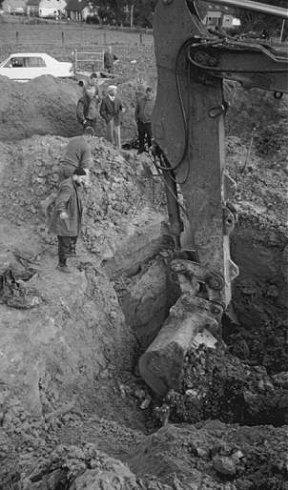
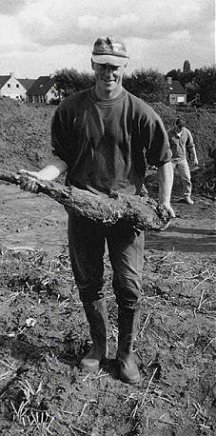

NOSE GUN BEFORE AND AFTER CLEANING
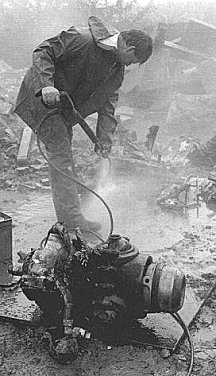
Wim Huyge in action on the cleaning site in Poperinge
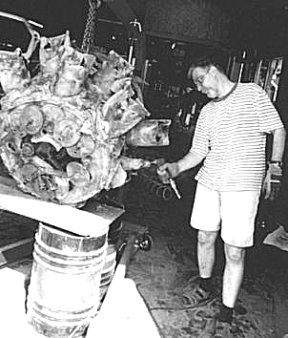
Dirk Decuypere cleaning one of the engines
Crew of Halifax LW394
F/O William McIntyre MARK – Pilot
P/O Ray F. DANIELS – Navigator
F/Sgt. William H. KETCHAM – Wireless Operator/Air
Gunner
F/O E. J. WOTHERSPOON –Bomb Aimer
P/O A. C. MCLEAN – Mid-upper Gunner
Sgt. J. J. “Paddy” WHYTE – Flight Engineer (RAF)
F/Sgt. Howard Alvin “Sandy” SANDERSON – Mid-under
Gunner
F/Sgt. A. A. ALGER – Rear Gunner
“As I recall, it was about 6:00 a.m. Feb. 9th. 1945. We were at 20,000 feet, bombed the target and were turning to starboard and increasing speed. We were struck by heavy flak, which we then knew was ‘predicted flak’, which was radar controlled flak. It registered our height, speed, direction, then fired several batteries at once at a predicted spot. It started a fire in the starboard engine. We used all our fire fighting equipment and almost put out the fire but then it spread to both engines and the starboard wing. The flames were strung out behind. The pilot ordered everybody out. The kite was about to explode.I left the mid-under bubble (with .50 Browning machine gun on a swivel) and went to the rear hatch. The other gunners were there. As the other gunners exited I Suddenly remembered my air force cap, which had the badge of the Leed City Police on it. I once wrote a short story called “The Badge” about how I got that badge and wore it on my 36 trips. I couldn’t leave my cap so I hurried forward to the rest position bench up front.
I got my cap, put it inside my flying suit and headed back to the rear hatch. When I was almost at the escape hatch, the kite suddenly turned over to starboard. I was thrown to the wall of the kite, which now became the floor. The hatch was now on the port wall, which was now the ceiling.
Meanwhile the pilot bailed out of the front hatch and I was alone. Flying solo in a burning Halifax was not my cup of tea, so I began to struggle to get to the ‘upper’ hatch. I was feeling very weak and drowsy. I had been off oxygen too long but didn’t know why I was so weak. I got partway out of the hatch. The kite was heading straight down at 350 m.p.h. I was pressed against the fuselage, while my legs were still inside the kite, caught on something. I quit struggling and went unconscious When I came to I was hanging limp in a parachute at about 8000 feet. I saw both my flight boots spiraling down below me. I saw the kite, a ball of flame, heading down far below. There was a very strong wind blowing. There was no sound up there….”
Sandy Sanderson hit the ground at a high speed and was dragged by his chute across a farmer’s field until he hit a fence. Apart from a sprained ankle, sore back and a few scratches, he was not injured.
The farm was near Zillebeke and the family made coffee for him. He had a bar of chocolate which he broke into squares and put on a table in front of some young children. They never moved until their mother gave the O.K. to help themselves. The farm where Sandy received help was that of Isidoor and Elza Lierman-Vanzandwege at Molenbos 2 in Zillebeke. The two young children are most likely Jozef and Godelieve Lierman.
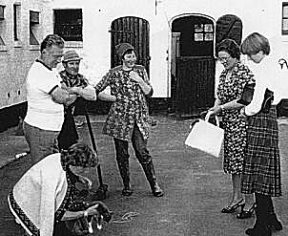
In 1977 Sandy Sanderson returned to the site of the crash.
Sandy is shown here with Jozef and Godelieve (immediate to his right)
the two Lierman children to whom he gave his chocolate on the day of the crash.We, of the Ex-Air Gunners of Canada, thank Dirk and Mieke , Wim and Inge, and all those who participated in this effort of PRESERVING THE PAST FOR THE FUTURE

In the February 2002 Short Bursts Page, a request was made for information on the Whitley aircraft.Many thanks to those who contributed information, Ted Hackett, Ted Turner, and Bill Cole.
The Whitley was the first into service of the “heavy” bombers which bore the brunt of Bomber Command’s early wartime offensive. The second was the Handley Page Hampden and the third was the Vickers Wellington.
The MkV was the most extensively produced version of the Whitley. Like the Mk1VA it was powered by Merlin X engines, but its fuselage was 15 inches longer, the result of an extra section having been added immediately aft of the rear most frame, to improve the rear gunner’s field of fire. Tail fins and rudders were redesigned, rubber de-icing boots were fitted on the leading edge of the wing. Fuel capacity was increased from 837 Imp. Gal. (normal) and 969 Imp. Gal. (max). The D/F loop was housed in a streamlined faring.
Top speed was 230 mph at 16,400 ft. and cruising speed 210 at 15,000 ft. Initial rate of clime was 800 ft. per min., time to 15,000 ft 16 minutes. The Whitley bomb load of 3,365 lbs. was carried in two separate bays in the fuselage and in a total of fourteen smaller cells in the wing. The doors, of wood and metal, opened under the weight of the falling bombs, and were closed by bungee. The aircraft had a cruising range of 1,300 miles. Considering all Mk’s there were 1,814 Whitleys built.
At the outbreak of the war the RAF had 196 Whitleys on charge. $ Group, commanded by the late Sir Arthur “Mary” Coningham, was the only trained night bomber force in existence anywhere in the world. Although it was propaganda leaflets, or “nickels, rather than bombs that were dropped on Germany at first, the Group lost no time in starting operations, the first “nickeling” mission being flown by ten Whitley 111s from Nos. 51 and l58 Squadrons on the first night of the war. They dropped six million pamphlets over the Ruhr and north west Germany. They were the first aircraft to penetrate into Germany in WW11. The first bombs dropped by 4 Group’s Whitleys was on Borkum and Sylt, 12/13 December 1939.
The Whiltley went on to serve in Bomber Command, Coastal Command, Transport, and glider towing.
A most amazing incident was one that involved 77 Sqdrn. Whitley V N1387 “L-Love” (F/L Tomlin) during a sortie to Warsaw on 15/16 March 1940; after dropping its “nickels” on Warsaw, the aircraft landed in Germany by mistake, stayed on the ground for quarter of an hour and, when the crew discovered the awful truth, got away with only seconds to spare!
Bill Cole served on a Whitley squadron and has built a radio-controlled Mk V Whitley. (See below)
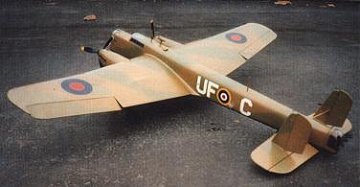
Returning to Heavy Conversion Unit at Topcliffe after a 5 hour 35 minute bull’s eye, the port engine failed, followed by the other three in rapid succession. The pilot asked the flight engineer if he had switched the fuel tanks for landing. “Yes” was the answer. The flight engineer told the pilot to feather the port engine. The pilot selected fine pitch and opened all four throttles to check for failed constant speed units.Meanwhile, the wireless operator, sitting in the crash position yelled that he thought he was in a whorehouse because of all the red lights that were on (the low pressure warning lights in the crash position). He jumped up and switched the fuel tanks. All four engines in fine pitch and throttles wide open, roared into life just as the aircraft was passing the control tower whereupon the tower operators took off out of the tower, as we recovered and circled the airfield for about thirty minutes while the pilot regained his composure and the aircraft was checked out. We landed safely.
The next morning the pilot and I saw the commanding officer. The Pilot told him that the Flight Engineer was in no way fit to fly, he had lied about switching the tanks and that he (the Pilot) would personally shoot him if he was not gone off the station that night. By the following morning he was gone.
Notes: A bulls eye was a nighttime trip to test the air defenses of Great Britain.
OBITUARIESSARSON, A. #0132, BURLINGTON, ON: 'Tony' passed away during the summer of 2001. After enlisting as R200836 he received his Gunnery Training at #1 BGS, Jarvis, ON and served overseas with 424 Squadron in 6 Group. In peacetime he was the Squadron Representative in the Hamilton Area, and was a member of the Commonwealth Aircrew Reunion which was held each fall in Toronto.
RUNCIMAN, D. R. #0339, BELLEVILLE, ON: Don passed away in February. He enlisted in May 1943 and attended Gunnery Training at #3 BGS at MacDonald, MB. Due to a Gunner's shortage was posted for advanced training of one weeks' duration at Wombleton then on to 6 Group and 433 Squadron where he completed his first 5 Operational Trips. Then posted to 427 Squadron at Leeming where he completed his tour, when he received his commission and was awarded the DFC.
DUGGAN, J. #0466, EDMONTON, AB: James passed way September 6,200 after a long illness. He enlisted in Winnipeg during 1941 and selected for Wireless training. Served on Guard Duty at Toronto waiting for course opening. Attended #4 WS at Guelph and #1 in Montreal with Gunnery Training at #7 BGS, Paulson, MB where he received his Brevet. Served at #20 PAED in Saskatoon, SK from where he received a Medical Discharge in 1945.
YORK, G. #0613, WINNIPEG, MB: Born February 27, 1924, George passed away March 11, 2002. Selected for Gunnery Training he attended Ground School at Quebec City then on to #3 BGS, Course #67 at MacDonald where he received his Brevet. Then overseas to #26 OTU and HCU at Chedburch, then #3 Finishing School at Feltwell. Posted to #149 Squadron in 3 Group where he completed 27 Ops before the war ended.
SHARPE, J. C. #1155, CALGARY, AB: James Carson passed away January 20, 2002, having been born on a farm at Glenavon, SK in 1916. Enlisted as C17283 and took Gunnery Training at Dalcross in Scotland. Completed a tour with #617 and #619 Squadrons in 4 Group as a rear gunner on Lancaster's. He was returned home to promote the sale of Victory Bonds and eventually returned to his vocation as a School Teacher.
BELL, R. #1204, SPRUCE GROVE, AB: Dick passed away suddenly on March 27, 2001. He enlisted in Edmonton on November 30, 1942 and attended #3 BGS at MacDonald, MB Overseas he received more training at OTU Ossington and #1659 HCU, then flew Ops with #434 'Bluenose' Squadron in RCAF #6 Group at Tholthorpe, Yorks.
PRATT, G.F. #1234, LEDUC, AB: George passed away suddenly on January 21, 2002. He enlisted in 1941 at Toronto and trained at #2 Wireless School, Calgary, Course #40 and graduating with his WAG Brevet from #4 BGS, Fingal, ON. He took further training at #111 OTU Nassau, Bahamas, and served overseas with #220 Squadron RAF.
EWATSKI, FRED, #0023, WINNIPEG, MB: Peacefully at age 81 on March 31st, 2002. Fred served proudly as President of our Association, beginning in 1983. He guided us through our growing pains before passing the mantle to Doug Penny. Fred was also a very active member of his Ukrainian Legion, Br. #141, and served in various offices. In 1953 he was the co-founder of 573 Air Cadet Squadron which was sponsored by his Legion Branch and served as the first Commanding Officer of that group, following which he became the Sponsoring Committee Chairman during the 70's.
Fred enlisted in the RCAF in September 1942 attending Brandon Manning Depot where he was selected for Gunnery Training. Following Tarmac Duty at Paulson #7 BGS he attended PAED at McGill University and from there was posted to #9 BGS at Mont Joli, PQ graduating 9-7-43. Overseas he was assigned to the RAF and took his OTU on Wellington A/C then posted to #159 Squadron on Liberators in India. He completed his tour 7-4-45 and was discharged November 6th, 1945.
HAYS, J. #1216, EDMONTON, AB: Born July 31st 1917, John passed away April 27th, 2002. Joined the RCAF 1941 and released in 1945. Attended Manning Depot at Penhold, AB and #2 W/S in Calgary with Bombing and Gennery at #8 B&G Lethbridge, AB. He flew operations with #458 (RAAF) Squadron in North Africa. He is survived by his Wife Barbara, 2 daughters 1 son and 2 grandchildren.
MOORE, C. #928, BILLINGHAM, Cleveland, UK: Clayton passed away May 1st. At the time of enlistment in 1942 he was a resident of Saskatoon, SK and trained as an Air Gunner. He completed a tour with #9 Squadron and then completed a second tour with the Pathfinders in #83 Squadron during 1943/44. He was commissioned as J89621 and attained the rank of Flying Officer. Following the end of the war he was repatriated to Canada but elected to return to Britain where he married and raised his family, and a was employed as a Firefighter.
(Note to Ted Hackett: Obit for Donald Sharpe #661 appeared in
July 2001 issue of Short Bursts.)
BRANCH REPORTS
Northern Saskatchewan Group
On Feb. 18/02, at the RCAF Lynx Wing, at noon, 20 of the North
Saskatchewan Ex A.G.'s & W.A.G.'s gathered for their monthly luncheon
and on March 18th. 2002, 17 members attended.At the March meeting the guest speaker was Bill Kondra DFM, who was a Flight Engineer.
We observed a moment of silence for Iris Ellison who passed away recently.
Lloyd Crossman is slowly but surely returning to good health.“Smokey” Robson – Pres.
Smokey tells us about one of his WWII experiences:
Bomber Command was very pre-occupied during the early part of 1942 with three German Capital ships. The ships were the Scharnhorst, the Gneisenau, and the Prinz Eugen that were at anchor in the French harbor of Brest.
On February 12 th. 1942 at 4:50 p.m. Wellington X9920 Captained by Wing Commander Fulton and his crew of which I, C. A. Robson, was a member, set course to attack the German battleships. There were two other Wellingtons in the group.
We flew out in formation at 9,000 ft. and at the appointed time, Wing Commander Fulton gave the order to descend and do a square search for the ships. Our crew did a square search at 400 ft. above the ocean but we saw nothing of the ships. However the other two aircraft must have come across the ships because, when we returned base, we were the only aircraft to come back. The other two were missing. The lose of two aircraft and two crews in the early days of 419 Squadron’s development, was a sad day.
(Ed. Thank you Smokey. It is great to see that your group is still active. It would be interesting to know how thw other groups across the country are making out.)
From Your Editor's KeyboardI want to thank those who have sent in material for the Web Page. It would be appreciated if the articles were short, not rambling, and had pictures. A picture is worth a thousand words (and it cuts down my typing time).
422 Squadron reunion Sept. 26 - 30, 2002 in Winnipeg, Manitoba. Particulars can be obtained from Jack Logan, 1116 Skana Dr. Delta, B.C. V4M 2L3. njlogan@telus.net
Don't forget to make a donation to the C.A.T.P. Museum in Brandon (address on this page) as they are hosting our Web Page at no cost to the Ex-AGs. Also, a big THANK YOU to our volunteer Web Master, Bill Hillman. Bill is presently teaching in Northern Manitoba and manages to work our Web Page into his busy schedule.
Doug Penny just returned from a vacation in Florida and says that he is feeling better. Charley Yule, who was our Secretary Treasurer during the life of our Association, is still active providing the obituaries for this page. Thanks Sir Charles.
Keep well, Cheers, John and Doreene Moyles.
|
Southern Ontario Chapter Royal Canadian Legion Wilson Branch 527 948 Sheppard Avenue West Downsview,Ontario We meet the first Wednesday of each month at the Legion hall 1:00 pm. No meetings July, August, September. Contact persons: Ken Hill ~ President ~ 905.789.1912 Bill Cockburn ~ Secretary ~ 416.492.1024 Email: piperbill@home.com Location - Royal Canadian Legion Br.#4 St. James Legion. Date - Second Thursday of each month. Time - Luncheon meeting (provide your own lunch). Contact Member - Charlie Yule Ph. (204) 254-6264. Northern Saskatchewan Location - Lynx Wing Ave. C North, Saskatoon. Date - Third Monday of the month. Time - Luncheon meetings. Contact Member - C.A. "Smokey" Robson Ph. (306) 374-0547. Northern Alberta Branch Location - Jasper Place Legion , 10220 - 156 St. Edmonton. Date - Third Tuesday of each month. Time - 12:00 hours. Contact Members - E. H. "Ted" Hackett (780)962-2904 or Sven Jensen (780)465-7344. Southern Alberta Location - Royal Canadian Legion #264 Kensington, Calgary Date: Second Monday of each month. Time - 11:30 hours. Contact Member: Dave Biggs Ph: (403)236-7895 or Doug Penny Ph: (403)242-7048. Note: October meeting time moved to third Monday. Also there are no meetings in July and August, however, a Barbecue is usually held at Larry Robinson's ranch in Okatoks during that time. British Columbia Branch Meeting time and local: 2nd Tuesday of each month at 12 noon,
Contact person - Dave Sutherland
Ph. (604) 431-0085
send current information regarding regular meeting places, dates, and Contact Members, to John Moyles Box 6 Kenosee Lake SK S0C 2S0
Members are requested to send their experiences, articles, anecdotes, pictures, etc., to John Moyles and I will forward them to our Web Master in Brandon. Articles and Last Post items will be deleted from the page each month after the designated Member in each region has had an opportunity to copy the material for their Members. Notices of deceased Members are to be sent to Charlie Yule who is still our 'Keeper of the Rolls'. This is your SHORT BURSTS with no printing or mailing costs, and no deadlines! We thank our Web Master, Bill Hillman, for his volunteer time and expertise. |
![]()
|
As You Were . . . Tribute Webzines |
Hillman WWII Tributes www.hillmanweb.com/war |
www.hillmanweb.com/rcaf RCN HMCS PRINCE ROBERT www.hillmanweb.com/rcn |
Ex-Air Gunners Association Magazines |
![]()
![]()
![]()
Webmaster:
William G. Hillman
BILL
& SUE-ON HILLMAN ECLECTIC STUDIO
Editor and Webmaster Bill Hillman
~ Copyright 1996-2021
©
2008 Bill Hillman and Ex-Air Gunners Association
